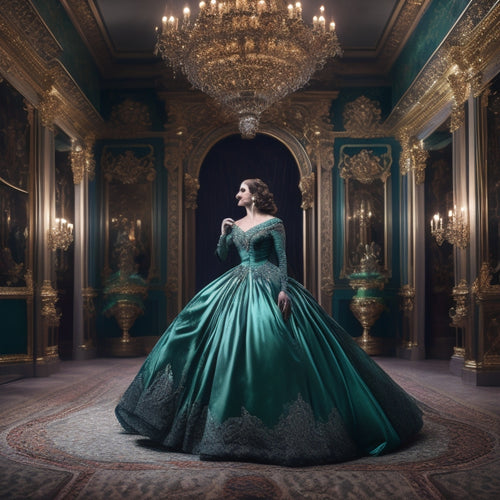
Enchanting Bharatanatyam: Preserving Indian Cultural Heritage
Share
Bharatanatyam, a revered classical dance form, embodies India's cultural heritage with its intricate movements, emotive expressions, and narratives rooted in ancient Hindu mythology. Originating in Tamil Nadu, India, this timeless tradition was nurtured in Hindu temples, where it flourished into a vibrant form of worship and storytelling. Characterized by expressive hand gestures, rhythmic footwork, and emotive eye expressions, Bharatanatyam creates a visually stunning display that perpetuates ancient traditions and myths. As an integral part of India's cultural identity, it fosters a deeper understanding and appreciation of cultural heritage, and its significance will unfold as we explore its beauty and cultural significance further.
Key Takeaways
• Bharatanatyam originates from Tamil Nadu, India, and is rooted in ancient Hindu temples, reflecting the region's rich cultural heritage.
• This classical dance form preserves Indian cultural identity by showcasing cultural diversity, spiritual essence, and perpetuating ancient traditions and myths.
• Bharatanatyam weaves narratives that transcend time and space, confirming the cultural preservation of ancient stories and educating future generations.
• The dance form creates a visually stunning display, reflecting intricate movements and emotive expressions, while enchanting audiences with spiritual storytelling.
• As an essential component of India's cultural identity, Bharatanatyam plays a significant role in preserving the country's cultural soul, fostering deeper understanding and appreciation of cultural heritage.
Origins of a Timeless Tradition
In the southern Indian state of Tamil Nadu, the revered traditional dance form of Bharatanatyam originated, deeply rooted in the ancient Hindu temples where it was nurtured and refined over time.
This classical dance form has its ancient roots in the sacred precincts of Hindu temples, where it was performed as a form of worship and storytelling. The temples provided a conducive environment for Bharatanatyam to flourish, with its intricate movements, expressive gestures, and emotive expressions.
Over time, the dance form evolved, absorbing the rich cultural heritage of the region, and today, it remains an integral part of India's cultural identity, showcasing the country's rich cultural diversity and spiritual essence.
Elements of a Classical Dance
As a classical dance form, Bharatanatyam's intricate language is comprised of expressive hand gestures, known as mudras, which convey emotions and tell stories.
These mudras are intricately woven with adavus, or rhythmic footwork patterns, to create a visually stunning display.
The dancer's eyes, or drishti, play a vital role in conveying the emotions and narrative of the dance.
The emphasis on bhava, or emotional expression, brings the dance to life, allowing the audience to connect with the story being told.
The harmonious blend of mudras, adavus, drishti, and bhava creates a rich tapestry of expression, making Bharatanatyam a truly enchanting classical dance form.
Preserving India's Cultural Soul
Bharatanatyam, an integral part of India's rich cultural heritage, plays a significant role in preserving the country's cultural soul by perpetuating ancient traditions and myths.
Through its intricate movements and expressive gestures, Bharatanatyam weaves a narrative that transcends time and space, connecting audiences with India's spiritual roots.
This classical dance form is a confirmation of the country's cultural preservation, ensuring that the stories of ancient India continue to inspire and educate future generations.
By embracing spiritual storytelling, Bharatanatyam not only entertains but also educates, fostering a deeper understanding and appreciation of India's cultural heritage.
As a result, Bharatanatyam remains an essential component of India's cultural identity, proudly preserving the country's cultural soul for generations to come.
Frequently Asked Questions
Can Bharatanatyam Be Learned by People of All Ages?
Fascinatingly, 70% of Bharatanatyam students start learning after age 30. Yes, Bharatanatyam can be learned by people of all ages, with beginner classes catering to new learners and elderly adaptations ensuring accessibility for seniors.
Are There Any Health Benefits Associated With Bharatanatyam?
Practicing Bharatanatyam offers numerous health benefits, including flexibility improvement through intricate footwork and expressive gestures, as well as posture correction through rigorous training, ultimately enhancing overall physical and mental well-being.
Can Bharatanatyam Be Performed to Modern or Contemporary Music?
"As the gramophone needle drops, Bharatanatyam's ancient rhythms synchronize with modern melodies, birthing fusion feats that revamp traditional tala patterns, proving this timeless art form can harmoniously blend with contemporary music, redefining its boundaries."
Are There Any Famous Bharatanatyam Dancers I Should Know About?
Notable Bharatanatyam dancers include Rukmini Devi, a pioneer in popularizing the art form, and Yamini Krishnamurthy, a renowned exponent known for her technical mastery and emotional expression, both contributing substantially to the dance form's global recognition.
Can Bharatanatyam Be Performed in a Group or Is It Solo Only?
In Bharatanatyam, both solo and group performances are valued, with Group Choreography showcasing synchronized movements and Traditional Ensemble pieces highlighting the beauty of collective storytelling, showcasing the art form's versatility and richness.
Related Posts
-

What Contemporary Dancewear Essentials Do Dancers Need
As a contemporary dancer, you need essentials that enhance your flexibility and creativity. Opt for high-waisted legg...
-

Dance Maestro Zoe Rappaport Steals the Spotlight
Zoe Rappaport's illustrious career has cemented her status as a visionary Maestro, driving innovation in movement dir...
-

Tutu Fun: Ballet Scrunchie Cards Dance Delight
Ballet enthusiasts can elevate their dance style with unique digital downloads, specifically designed ballet-inspired...


